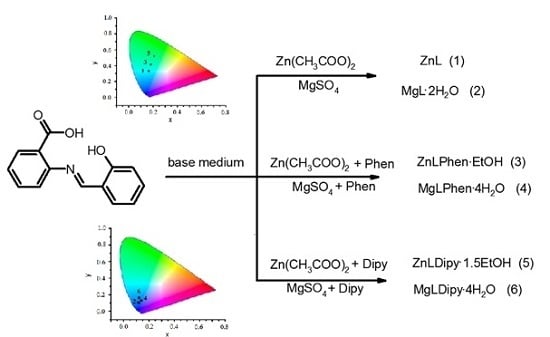Luminescent Properties of Zn and Mg Complexes on N-(2-Carboxyphenyl)salicylidenimine Basis
Abstract
:1. Introduction
2. Results
2.1. General Characterization
2.2. Structures of Complex 5
2.3. Photophysical Studies
3. Materials and Methods
4. Conclusions
Acknowledgments
Author Contributions
Conflicts of Interest
References
- Wang, S. Luminescence and electroluminescence of Al(III), B(III), Be(II) and Zn(II) complexes with nitrogen donors. Coord. Chem. Rev. 2001, 215, 79–98. [Google Scholar] [CrossRef]
- Evans, R.C.; Douglas, P.; Winscom, C.J. Coordination complexes exhibiting room-temperature phosphorescence: Evaluation of their suitability as triplet emitters in organic light emitting diodes. Coord. Chem. Rev. 2006, 250, 2093–2126. [Google Scholar] [CrossRef]
- Yam, V.W.-W.; Au, V.K.M.; Leung, S.Y.-L. Light-Emitting Self-Assembled Materials Based on d8 and d10 Transition Metal Complexes. Chem. Rev. 2015, 115, 7589–7728. [Google Scholar] [CrossRef] [PubMed]
- Rezaeivala, M.; Keypour, H. Schiff base and non-Schiff base macrocyclic ligands and complexes incorporating the pyridine moiety–The first 50 years. Coord. Chem. Rev. 2014, 280, 203–253. [Google Scholar] [CrossRef]
- Kuz’mina, N.P.; Eliseeva, S.V. Photo and Electroluminescence of Lanthanide(III) Complexes. Russ. J. Inorg. Chem. 2006, 51, 73–88. [Google Scholar] [CrossRef]
- Xie, J.; Qiao, J.; Wang, L.; Xie, J.; Qiu, Y. An azomethin-zinc complex for organic electroluminescence: Crystal structure, thermal stability and optoelectronic properties. Inorg. Chim. Acta 2005, 358, 4451–4458. [Google Scholar] [CrossRef]
- Jang, Y.-K.; Kima, D.-E.; Kim, W.-S.; Kwon, O.-K.; Lee, B.-J.; Kwon, Y-S. Electroluminescent properties of organic light emitting diodes using Zn(HPB)2 and Zn(HPB)q. Colloids Surf. A Physicochem. Eng. Asp. 2006, 284–285, 331–334. [Google Scholar] [CrossRef]
- Son, H.-J.; Han, W.S.; Chun, J.-Y.; Kang, B.-K.; Kwon, S.-N.; Ko, J.; Han, S.J.; Lee, C.; Kim, S.J.; Kang, S.O. Generation of Blue Light-Emitting Zinc Complexes by Band-Gap Control of the Oxazolylphenolate Ligand System: Syntheses, Characterizations, and Organic Light Emitting Device Applications of 4-Coordinated Bis(2-oxazolylphenolate) Zinc(II) Complexes. Inorg. Chem. 2008, 47, 5666–5676. [Google Scholar] [CrossRef] [PubMed]
- Kotova, O.V.; Eliseeva, S.V.; Averjushkin, A.S.; Lepnev, L.S.; Vaschenko, A.A.; Rogachev, A.Y.; Vitukhnovskii, A.G.; Kuzmina, N.P. Zinc(II) complexes with Schiff bases derived from ethylenediamine and salicylaldehyde: The synthesis and photoluminescent properties. Russ. Chem. Bull. Int. Ed. 2008, 57, 1880–1889. [Google Scholar] [CrossRef]
- Deda, M.L.; Ghedini, M.; Aiello, I.; Grisolia, A. A New Blue Photoluminescent Salen-like Zinc Complex with Excellent Emission Quantum Yield. Chem. Lett. 2004, 33, 1060–1062. [Google Scholar] [CrossRef]
- Gusev, A.N.; Shul’gin, V.F.; Konnic, O.V.; Meshkova, S.B.; Aleksandrov, G.G.; Kiskin, M.A.; Eremenko, I.L.; Linert, W. New Zn complexes based on 1,2,4-triazoles: Synthesis, structure and luminescence. Inorg. Chim. Acta 2011, 376, 509–514. [Google Scholar] [CrossRef]
- Chen, L.; Qiao, J.; Xie, J.; Duan, L.; Zhang, D.; Wang, L.; Qiu, Y. Substituted azomethine–zinc complexes: Thermal stability, photophysical, electrochemical and electron transport properties. Inorg. Chim. Acta 2009, 362, 2327–2333. [Google Scholar] [CrossRef]
- Dumur, F.; Contal, E.; Wantz, G.; Gigmes, D. Photoluminescence of Zinc Complexes: Easily Tunable Optical Properties by Variation of the Bridge between the Imido Groups of Schiff Base Ligands. Eur. J. Inorg. Chem. 2014, 2014, 4186–4198. [Google Scholar] [CrossRef]
- Ligtenbarg, A.G.J.; Hage, R.; Meetsma, A.; Feringa, B.L. Hydrogen bonding properties and intermediate structure of N-(2-carboxyphenyl)salicylidenimine. J. Chem. Soc. Perkin Trans. 1999, 2, 807–812. [Google Scholar] [CrossRef]
- Ju, W.-Z.; Shi, L.; Chen, K.; Xue, J.-Y. Catena-Poly[[zinc(II)-µ-[2-(2-carboxylatophenyliminomethyl)phenolato-1k3O,N,O’:1’kO’’]]methanol solvate]. Acta Cryst. 2005, 61, 1427–1428. [Google Scholar]
- SHELXL97; Program for the Refinement of Crystal Structures; University of Göttingen: Göttingen, Germany, 1997.
- Sheldrick, G.M. A short history of SHELX. Acta Crystallogr. 2008, 64, 112–122. [Google Scholar] [CrossRef] [PubMed]
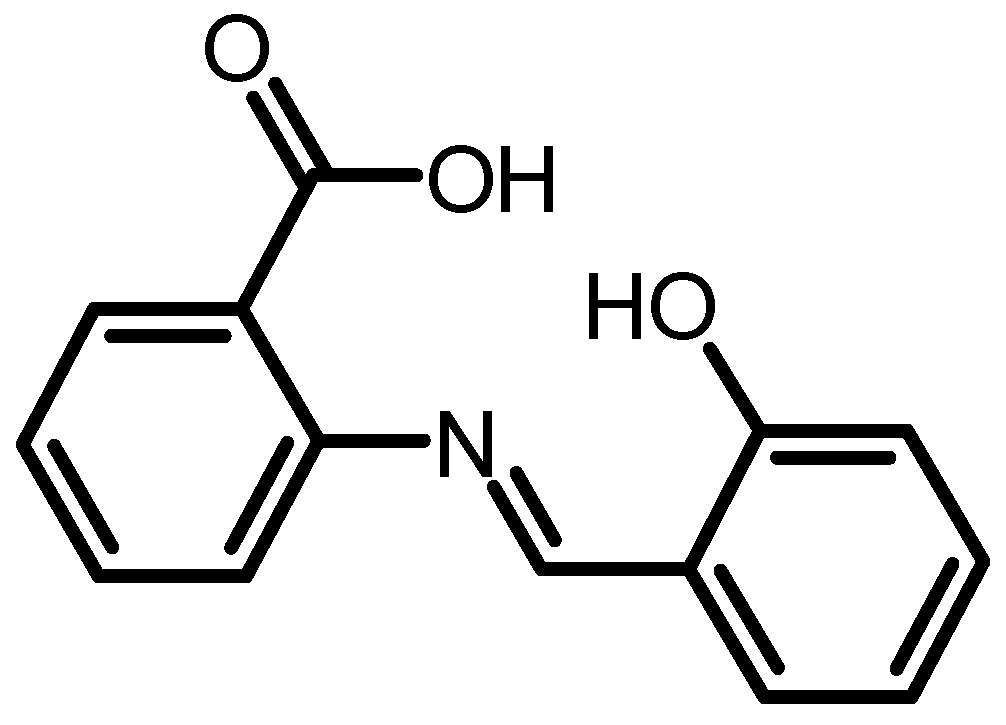
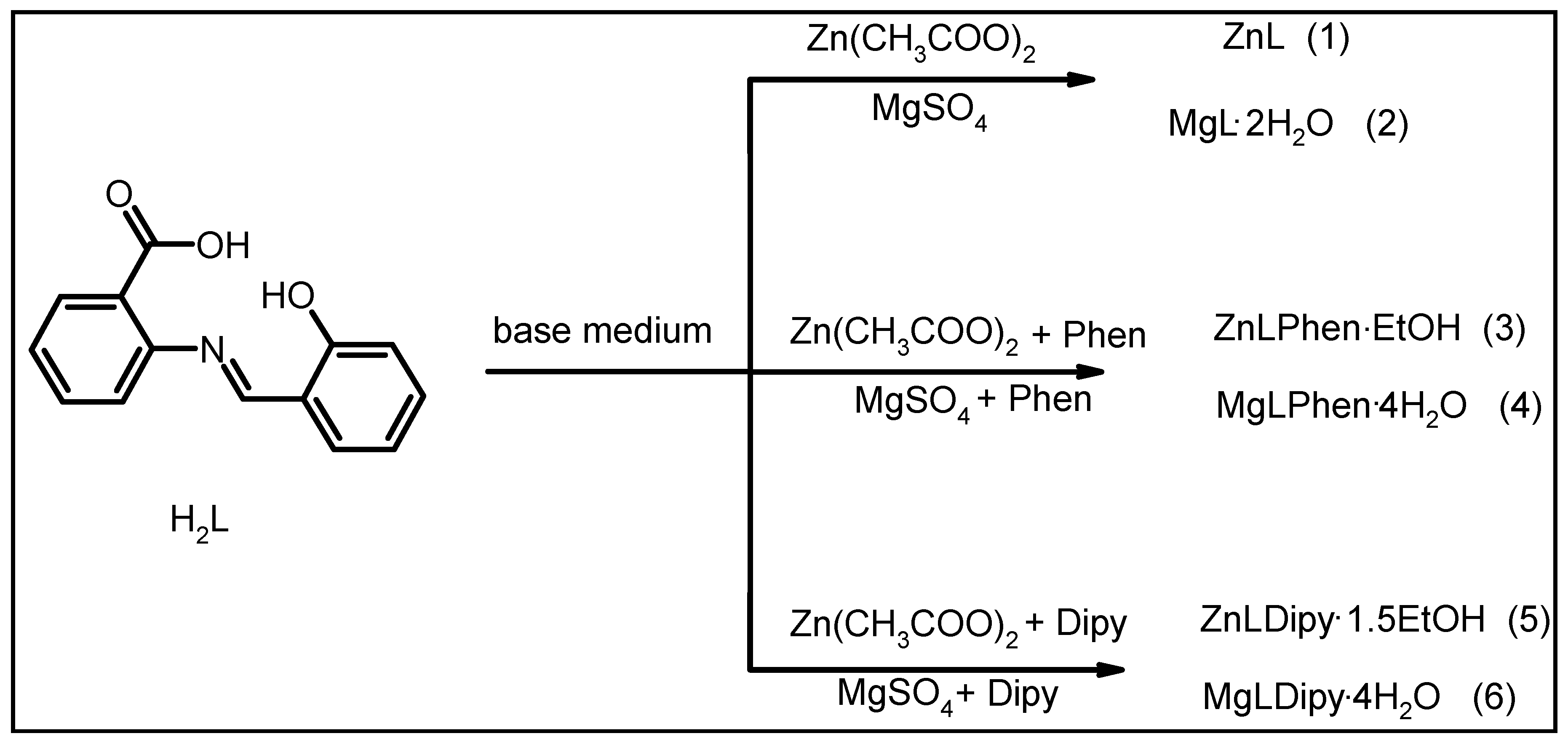

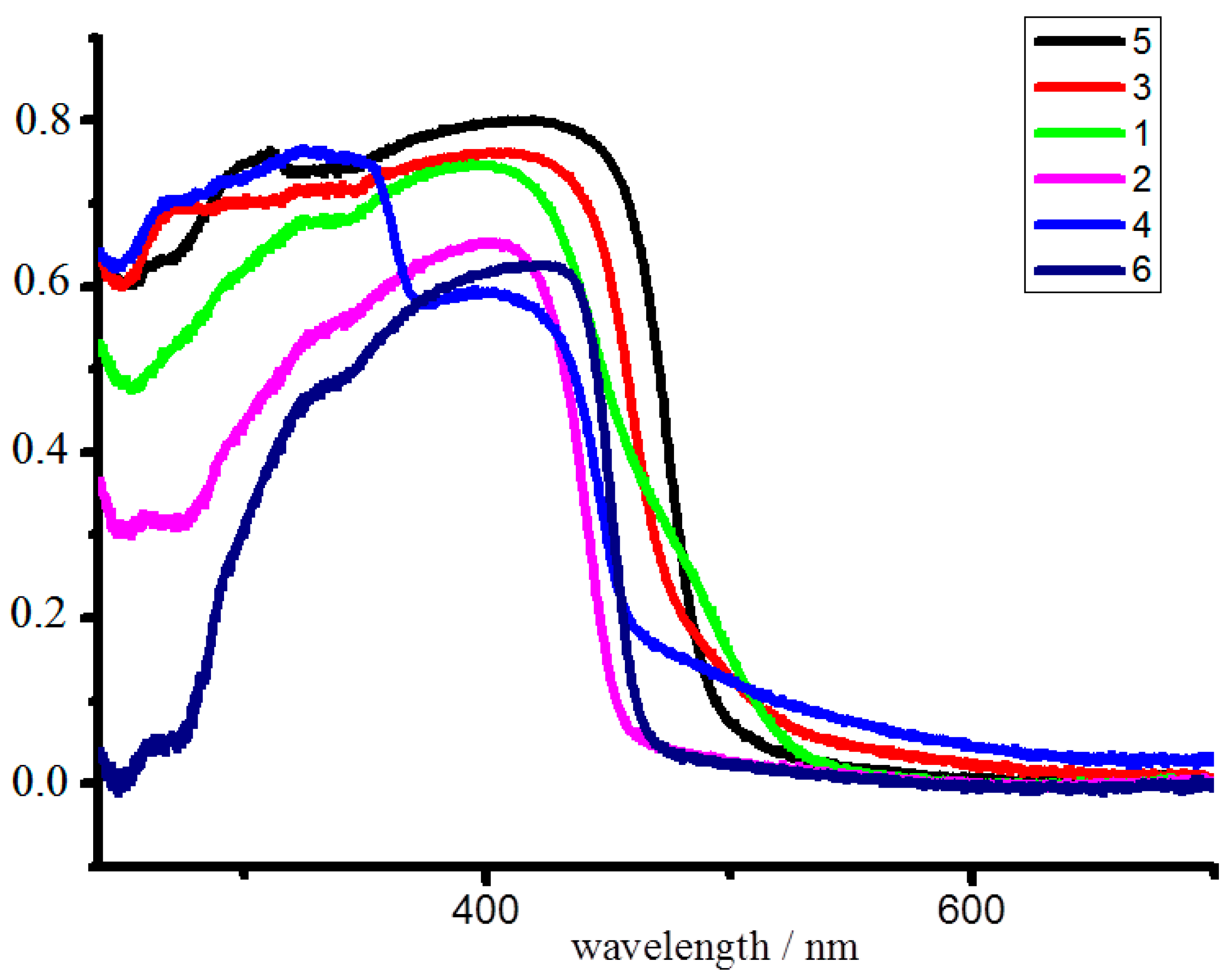
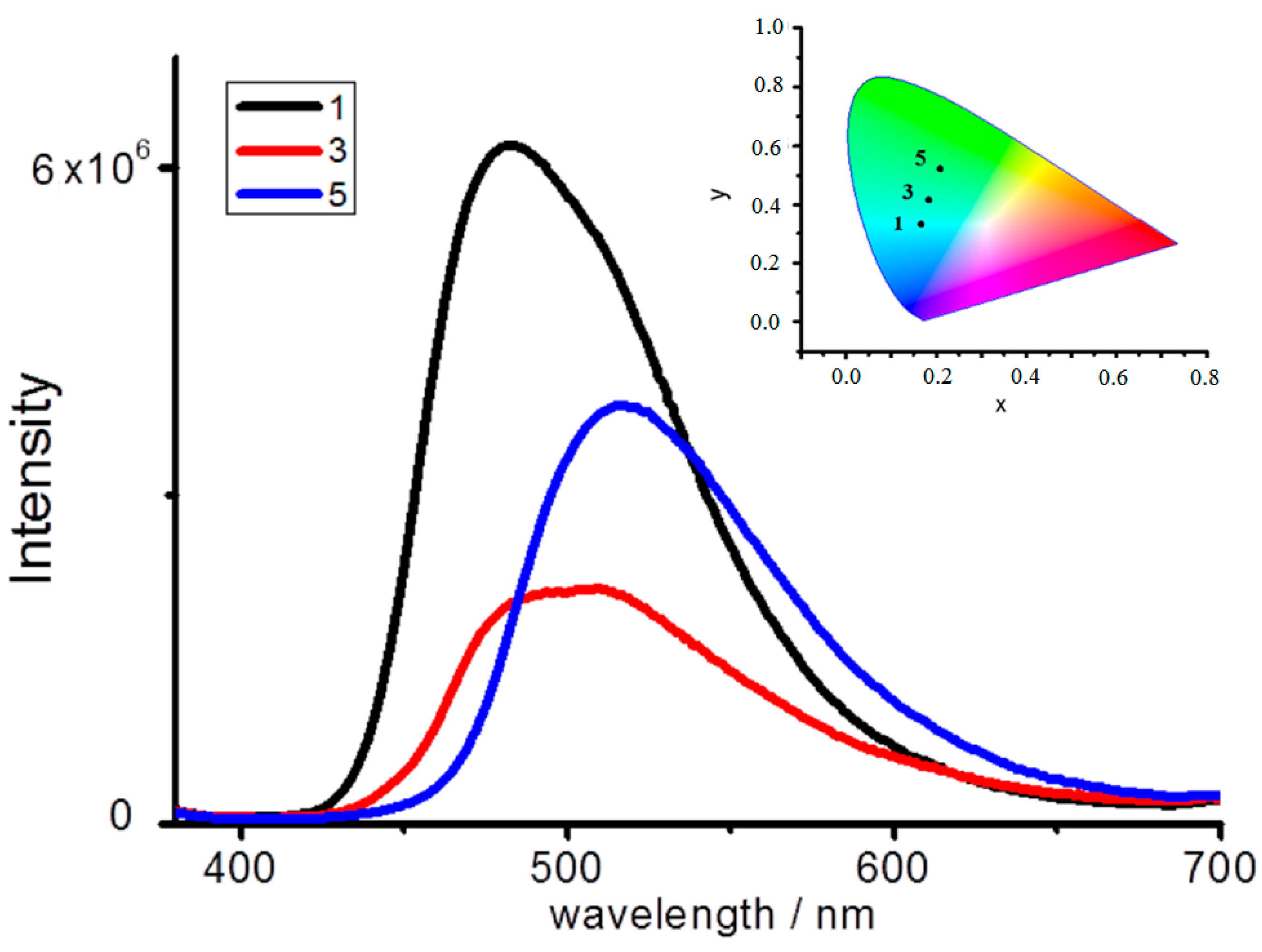
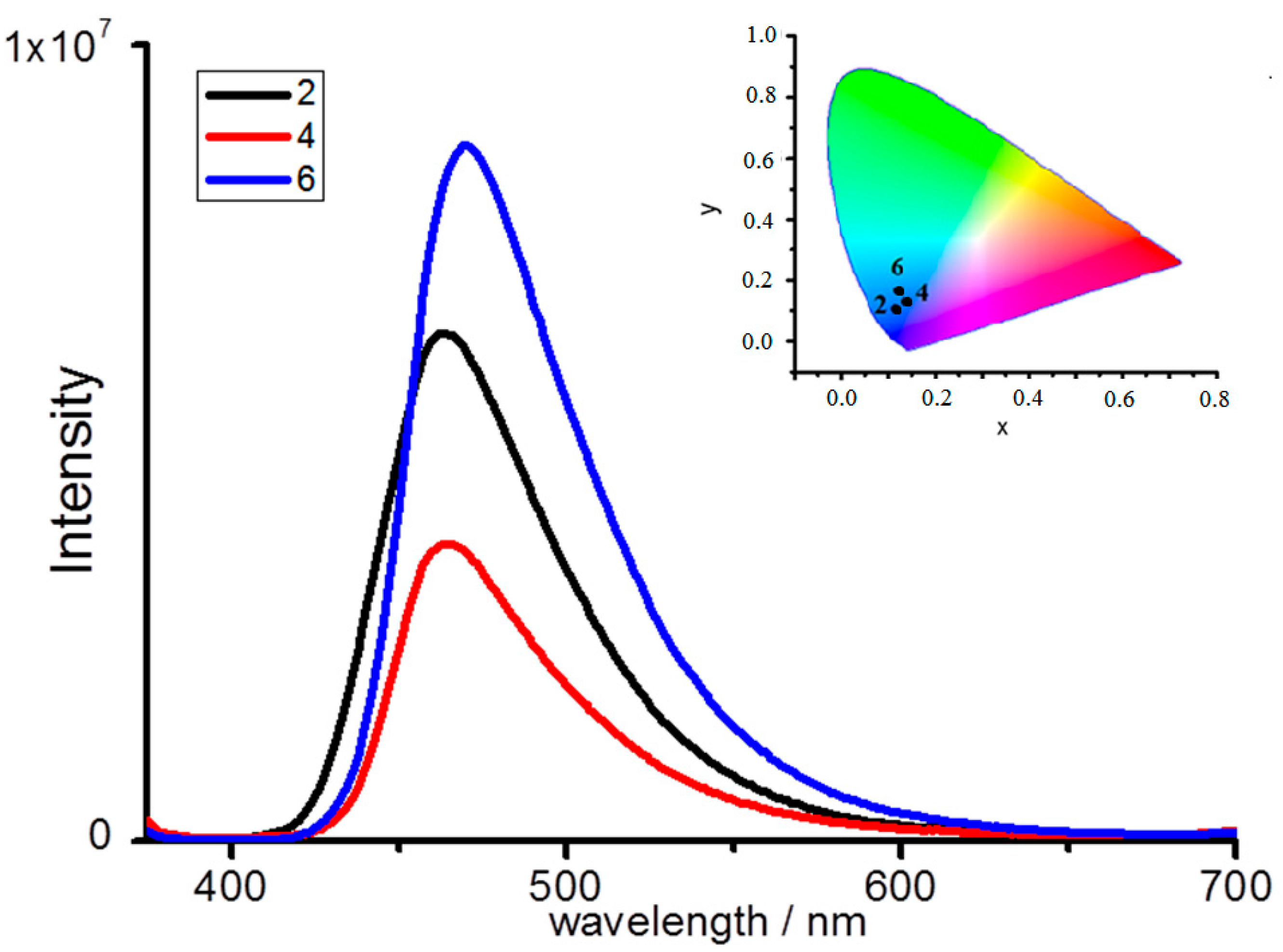

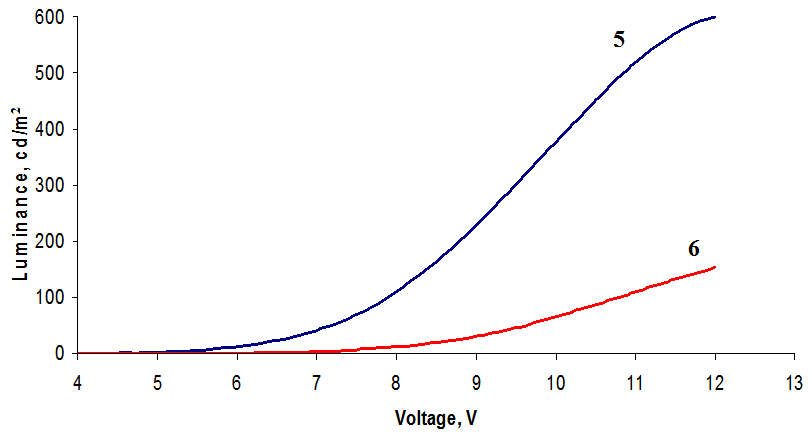
| Parameter | Complex 5 | |
|---|---|---|
| Formula | C26H20N4O3Zn | |
| Crystal system | triclinic | |
| Space group | ||
| Unit cell parameters | а, Å b, Å c, Å V, Å3 α, ° β, ° γ, ° Z | 9.1160(8) 9.9081(9) 12.8594(12) 1098.11(17) 77.375(2) 80.345(2) 77.619(2) 2 |
| Pcalc. g⋅cm−3 | 1.518 | |
| μMo. mm−1 | 1.156 | |
| F(000) | 592 | |
| θmax. deg | 2.143–28.997 | |
| Index ranges | −12 ≤ h ≤ 12 −13 ≤ k ≤ 13 −17 ≤ l ≤ 17 | |
| Reflections measured/reflections independent | 5860/4570 | |
| GOOF | 1.008 | |
| R (all data) | R1 = 0.0574 wR2 = 0.1077 | |
| R(I > 2σ(I)) | R1 = 0.0406 wR2 = 0.0986 | |
| Residual electron density (max/min). е/Å3 | 0.885/−0.282 | |
| Complex | Absorbance λmax (nm) | Emission λmax (nm) | Quantum Yield (%) | Lifetime (ns) | CIE Coordinates |
|---|---|---|---|---|---|
| 1 | 323, 399 | 482 | 31.2 | 3.6 | 0.172; 0.344 |
| 2 | 326, 401 | 463 | 39.9 | 4.2 | 0.142; 0.155 |
| 3 | 324, 406 | 508 | 11.0 | 2.6 | 0.235; 0.461 |
| 4 | 328, 402 | 464 | 19.0 | 3.6 | 0.143; 0.179 |
| 5 | 311, 416 | 515 | 16.9 | 3.1 | 0.281; 0.584 |
| 6 | 331, 424 | 469 | 41.4 | 3.8 | 0.141; 0.208 |
| Complex | Property | Yield (%) | FTIR (KBr, cm−1) | Element Anal. Calc. (%) | Found (%) | |
|---|---|---|---|---|---|---|
| 1 | ZnL (C14H9NO3Zn) | light-yellow solid | 85 | 1627, 1601, 1539, 1451, 1411, 1304, 1179, 743, 715, 542 | C, 55.20; H, 3.98; N, 4.59 | C, 55.06; H, 3.96; N, 4.80 |
| 2 | MgL·2H2O (C14H13MgNO5) | light-yellow solid | 51 | 3405, 2794, 1660, 1607, 1532, 1470, 1418, 1333, 1179, 1155, 1127, 900, 753, 730, 660, 509 | C, 56.13; H, 4.37; N, 4.68 | C, 55.52; H, 4.86; N, 4.42 |
| 3 | ZnLPhen·EtOH (C28H23N3O4Zn) | yellow solid | 74 | 3415, 1622, 1593, 1548, 1448, 1368, 1309, 1179, 1151, 847, 764, 727 | C, 63.34; H, 4.37; N, 7.92 | C, 63.17; H, 4.51; N, 7.94 |
| 4 | MgLPhen·4H2O (C26H25MgN3O7) | yellow solid | 41 | 3431, 3329, 1664, 1610, 1572, 1532, 1456, 1385, 1302, 1177, 1158, 1124, 840, 762, 727 | C, 60.54; H, 4.88; N, 8.15 | C, 60.11; H, 5.38; N, 8.32 |
| 5 | ZnLDipy·1.5EtOH (C27H26N3O4.5Zn) | yellow solid | 68 | 3438, 1619, 1601, 1560, 1530, 1447, 1361, 1316, 1174, 1147, 1025, 866, 764, 719 | C, 61.24; H, 4.91; N, 7.93 | C, 61.12; H, 4.70; N, 8.04 |
| 6 | MgLDipy·4H2O (C24H25MgN3O7) | light-yellow solid | 42 | 3464, 3187, 2797, 1664, 1605, 1534, 1475, 1421, 1335, 1180, 1158, 1124, 902, 757, 734, 663 | C, 58.61; H, 5.12; N, 8.54 | C, 58.21; H, 4.98; N, 8.22 |
© 2017 by the authors. Licensee MDPI, Basel, Switzerland. This article is an open access article distributed under the terms and conditions of the Creative Commons Attribution (CC BY) license (http://creativecommons.org/licenses/by/4.0/).
Share and Cite
Gusev, A.; Braga, E.; Shul’gin, V.; Lyssenko, K.; Eremenko, I.; Samsonova, L.; Degtyarenko, K.; Kopylova, T.; Linert, W. Luminescent Properties of Zn and Mg Complexes on N-(2-Carboxyphenyl)salicylidenimine Basis. Materials 2017, 10, 897. https://doi.org/10.3390/ma10080897
Gusev A, Braga E, Shul’gin V, Lyssenko K, Eremenko I, Samsonova L, Degtyarenko K, Kopylova T, Linert W. Luminescent Properties of Zn and Mg Complexes on N-(2-Carboxyphenyl)salicylidenimine Basis. Materials. 2017; 10(8):897. https://doi.org/10.3390/ma10080897
Chicago/Turabian StyleGusev, Alexey, Elena Braga, Victor Shul’gin, Konstantin Lyssenko, Igor Eremenko, Lybov Samsonova, Konstantin Degtyarenko, Tatiana Kopylova, and Wolfgang Linert. 2017. "Luminescent Properties of Zn and Mg Complexes on N-(2-Carboxyphenyl)salicylidenimine Basis" Materials 10, no. 8: 897. https://doi.org/10.3390/ma10080897




